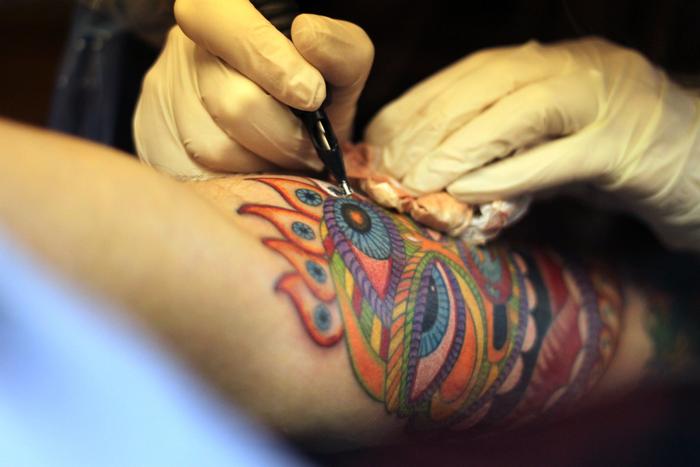Green and blue tattoo inks from Europe may contain ingredients that are not listed on the label, and some contained ingredients that are banned, according to a new study from Binghamton University, State University of New York.
Tattoo inks in Europe are regulated by the European Union’s Registration, Evaluation, Authorization, and Restriction of Chemicals (REACH) regulations, which were instituted in 2022. These limit the use of approximately 4,000 substances and some inks, including Pigment Blue 15:3 and Pigment Green 8, have been banned for use entirely.
In the new study, researchers analyzed ten green and blue inks from five different manufacturers distributed to the European market, all of which claim to be REACH compliant. The same lab had previously conducted a study of tattoo inks in the U.S. which found that 45 out of 54 inks didn’t match the contents listed on the label.
“Our work cannot say anything about the safety of tattoos, but we think it’s an important first step in addressing the question ‘Are tattoos safe?’ says study author Binghamton University chemist John Swierk, in a news release. “If we don’t know what’s in a bottle of tattoo ink, then we cannot figure out what might be causing an adverse event in the near and long term, whether that’s an allergic reaction or something more serious. As a team, we aren’t anti-tattoo, we just believe that clients and artists have a right to know what’s in the inks they are using.”
Swierk’s lab used a variety of techniques to analyze the inks, the primary method being Raman analysis.
The study saw two main results:
- Nearly all of the inks (9 out of 10) were not compliant with REACH regulations. In some cases, it was just a matter of not listing all of the components but in the case of four inks, it’s because they contained materials specifically prohibited by REACH.
- The main method, Raman Spectroscopy, for determining which structure of Pigment Blue 15 is in use, is unreliable. There are three common structures of Pigment Blue 15, but only one is banned by REACH. The researchers showed that different instruments cannot reliably distinguish which form is present, meaning that manufacturers do not have an easy way of confirming that they are receiving the correct Pigment Blue 15 structure. Thus, the ban on Pigment Blue 15 t as currently written, is unenforceable.
“There are regulations on the book that are not being complied with, at least in part because enforcement is lagging,” says Swierk. “Our work cannot determine whether the issues with inaccurate tattoo ink labeling is intentional or unintentional, but at a minimum, it highlights the need for manufacturers to adopt better manufacturing standards. At the same time, the regulations that are on the books need to be enforced and if they cannot be enforced, like we argue in the case of Pigment Blue 15, they need to be reevaluated.”
Swierk’s lab is continuing to look at tattoo inks, specifically their composition, to get a better idea of how pigments are dispersed and whether there are causes for concern.
“Our main areas of focus is understanding how tattoo pigments break down in light, specifically the type of laser light used in tattoo removal, and getting a better idea of the mechanics of how tattoos are inserted into the skin,” says Swierk.


